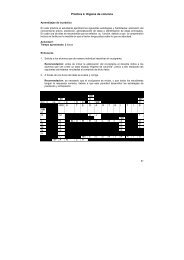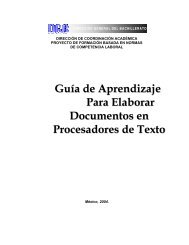Cálculo Diferencial e Integral II - Colegio de Bachilleres del Estado ...
Cálculo Diferencial e Integral II - Colegio de Bachilleres del Estado ...
Cálculo Diferencial e Integral II - Colegio de Bachilleres del Estado ...
You also want an ePaper? Increase the reach of your titles
YUMPU automatically turns print PDFs into web optimized ePapers that Google loves.
Teorema fundamental <strong>de</strong>l cálculo y las aplicaciones <strong>de</strong> la integral <strong>de</strong>finida<br />
INSTRUCCIONES: Resuelve las siguientes integrales y problemas, y preséntalos a tu profesor.<br />
I. Evalúa las siguientes integrales.<br />
2<br />
1. ∫ −<br />
2. ∫ −<br />
2<br />
π<br />
π<br />
2<br />
( 4x<br />
+ 5)<br />
dx<br />
(cos x + sen x)<br />
dx<br />
5 1<br />
3. ∫ dx<br />
3 x − 2<br />
4. ∫ e<br />
x dx<br />
1 ln<br />
1<br />
e x<br />
3<br />
5. ∫1 2<br />
x<br />
dx<br />
π<br />
2 sen x<br />
6. ∫ dx<br />
0 1+<br />
cos x<br />
7. ∫<br />
EJERCICIO DE<br />
REFORZAMIENTO 1<br />
6<br />
3<br />
2<br />
2<br />
(cos x + sen x)<br />
dx<br />
<strong>II</strong>. Resuelve los siguientes problemas.<br />
Nombre _________________________________________________________<br />
Núm. <strong>de</strong> lista ____________ Grupo ________________ Turno __________<br />
Núm. <strong>de</strong> Expediente ___________________ Fecha ____________________<br />
1. Para cierta población supongamos que la función l (x)<br />
representa el número <strong>de</strong> personas que<br />
alcanzan la edad x en cualquier año. Esta función se llama función <strong>de</strong> la tabla <strong>de</strong> vida. Bajo<br />
condiciones apropiadas, la integral ∫ +n x<br />
l ( t)<br />
dt da el número esperado <strong>de</strong> gente en la población<br />
x<br />
que tiene exactamente x y x + n , inclusive. Si l( x)<br />
= 10,<br />
000 100 − x , <strong>de</strong>termina el número<br />
<strong>de</strong> gente que tiene exactamente entre 36 y 64 años inclusive. Da tu respuesta al entero más<br />
cercano, ya que respuestas fraccionarias no tienen sentido.<br />
∫ −<br />
10<br />
4<br />
2<br />
2. En un estudio sobre mutación genética, aparece la siguiente integral x dx . Evalúa la<br />
0<br />
integral.<br />
3. El economista Pareto ha establecido una ley empírica <strong>de</strong> distribución <strong>de</strong> ingresos superiores que<br />
dN −B<br />
da el número N <strong>de</strong> personas que reciben x o más dólares. Si = −Ax<br />
, don<strong>de</strong> A y B<br />
dx<br />
son constantes, encuentra una expresión que te represente el número total <strong>de</strong> personas que<br />
reciben $ 100 o más dólares.<br />
− 1<br />
101

















